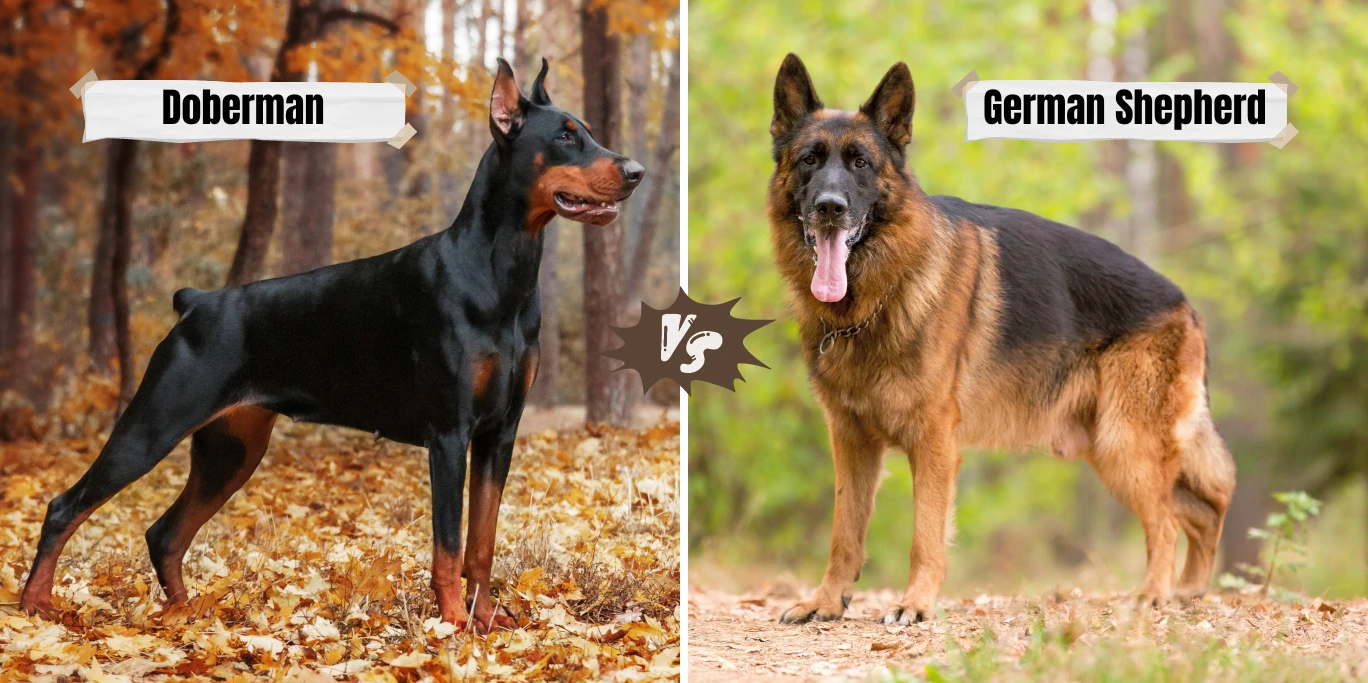
The world of dog breeds is vast and diverse, with each breed carrying its unique set of traits, history, and charm. Among the most esteemed and recognized breeds are the Doberman and the German Shepherd.
Both hailed for their intelligence, loyalty, and commanding presence, these breeds have long been favorites for families, service roles, and guardianship.
But how does one choose between the sleek, agile Doberman and the robust, versatile German Shepherd?
This article delves deep into a side-by-side comparison of these two iconic breeds, including their histories, temperaments, physical attributes, and more, helping prospective dog owners and enthusiasts understand their distinct characteristics and determine which might be the ideal companion for their lifestyle.
Whether you’re drawn to the Doberman’s vigilant nature or the German Shepherd’s multi-faceted capabilities, this comprehensive guide will offer insights that cater to both the heart and the mind.
| Breed Comparison | Doberman Pinscher | German Shepherd |
|---|---|---|
| Weight | 60 - 100 pounds | 50 - 90 pounds |
| Height | 24 - 28 inches | 22 - 26 inches |
| Size | Medium to large | Medium to large |
| Temperament | Alert, intelligent, fearless | Intelligent, loyal, courageous |
| Trainability | 4.0 out of 5.0 stars4.0 | 5.0 out of 5.0 stars5.0 |
| Energy Level | 4.0 out of 5.0 stars4.0 | 5.0 out of 5.0 stars5.0 |
| Life Expectancy | 10 - 12 years | 7 - 10 years |
| Shedding | 2.0 out of 5.0 stars2.0 | 5.0 out of 5.0 stars5.0 |
| Hypoallergenic | No | No |
| Puppy Costs | $1,500 - $2,500 | $800 - $10,000 |
Origins and History: Doberman vs. German Shepherd
Doberman
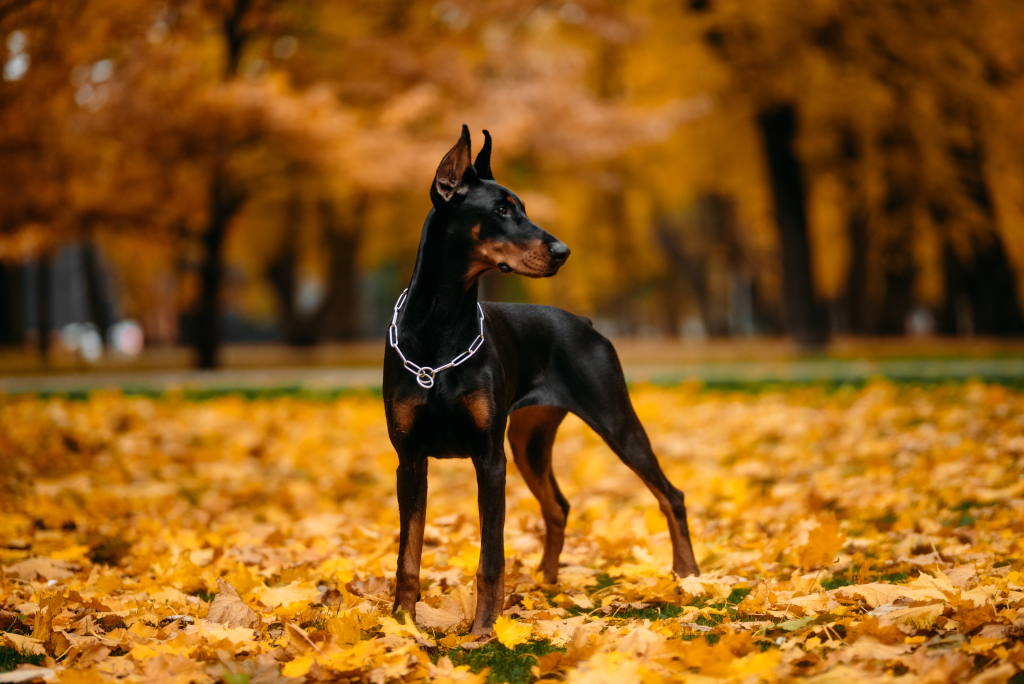
The Doberman Pinscher, commonly referred to as the Doberman originated in Germany in the late 19th century.
The breed was named after a tax collector, Louis Dobermann, who sought to create a medium-sized guard dog to accompany him during his work. To achieve this, he crossbred several dogs, including the Rottweiler, Black and Tan Terrier, Great Dane, Weimaraner, and the German Pinscher.
The result was a loyal, alert, fearless breed with a natural instinct to protect its owner and property. The Doberman quickly gained popularity and was soon recognized for its potential in police work, search and rescue, and military roles.
German Shepherd
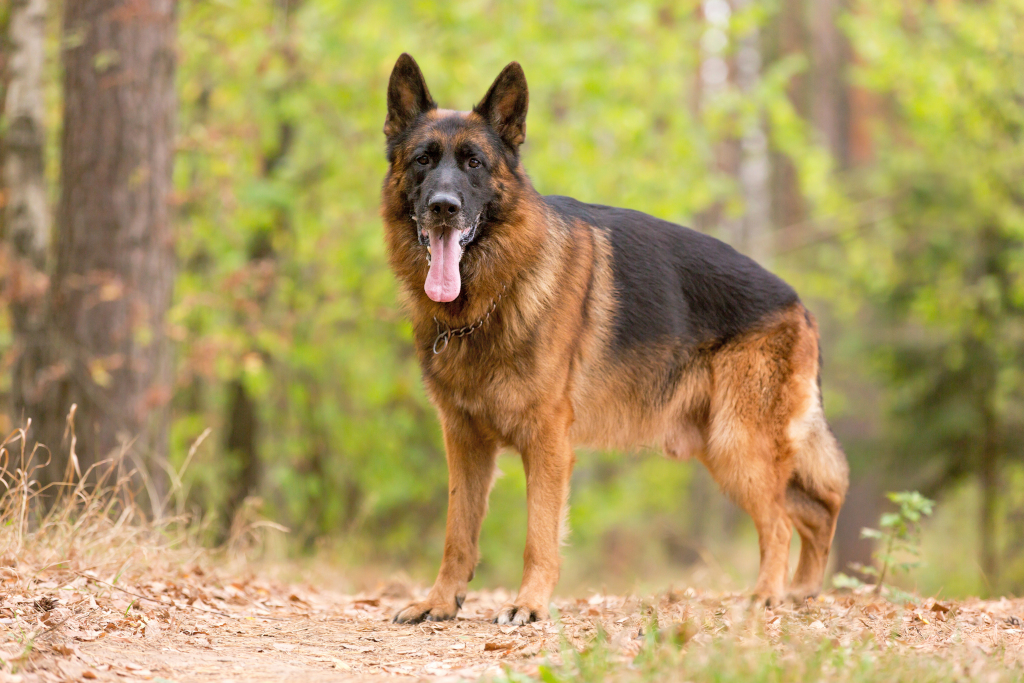
The German Shepherd’s origins can also be traced back to Germany, and this breed, too, developed in the late 1800s.
Captain Max von Stephanitz, an ex-cavalry captain and a former student of the Berlin Veterinary College, is credited with the breed’s inception. He wanted to develop the perfect herding dog, emphasizing intelligence, loyalty, and working capabilities.
By selecting and breeding the finest herding dogs from different parts of Germany, Captain von Stephanitz gave birth to the German Shepherd breed we know today.
The German Shepherd’s versatility was quickly recognized, and the breed was soon employed in various roles, from herding to military and police work and even as guide dogs.
| Aspect | Doberman | German Shepherd |
|---|---|---|
| Origin | Germany | Germany |
| Primary Developer | Louis Dobermann | Captain Max von Stephanitz |
| Time of Origin | Late 19th century | Late 19th century |
| Initial Purpose | Guard dog for personal protection | Herding & working dog |
| Notable Roles | Police, Military, Guard dogs | Police, Military, Herding, Guide dogs |
| Year Recognized by the American Kennel Club | 1908 | 1908 |
** Comparison Table: Doberman vs. German Shepherd - Historical Background
Note: While both breeds hail from Germany and were developed around the same timeframe, their initial purposes and the vision behind their inception varied. The Doberman was primarily tailored for personal protection, while the German Shepherd was crafted as a versatile working and herding dog. Both breeds, however, have proven their adaptability and prowess in various roles beyond their original intentions.
Comparing Physical Appearance
Doberman
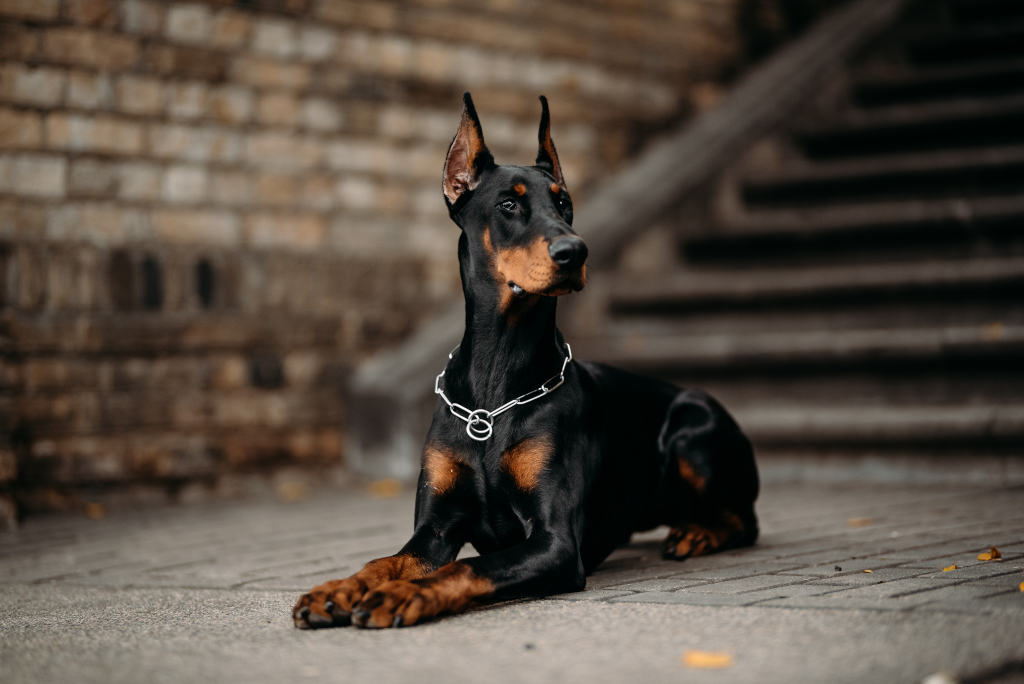
The Doberman is a paragon of elegance, boasting a compact, muscular build that speaks to both agility and power.
Standing tall on straight legs, their stance exudes confidence. Males typically weigh between 75 to 100 pounds and stand about 26 to 28 inches tall, while females are slightly smaller, usually weighing between 60 to 90 pounds and standing 24 to 26 inches tall.
Their heads are wedge-shaped, leading down to a robust neck and a deep, broad chest. Their sleek, short coats can be found in various colors, including black, red, blue, and fawn, with rust-colored markings above each eye, on the muzzle, chest, and legs.
German Shepherd
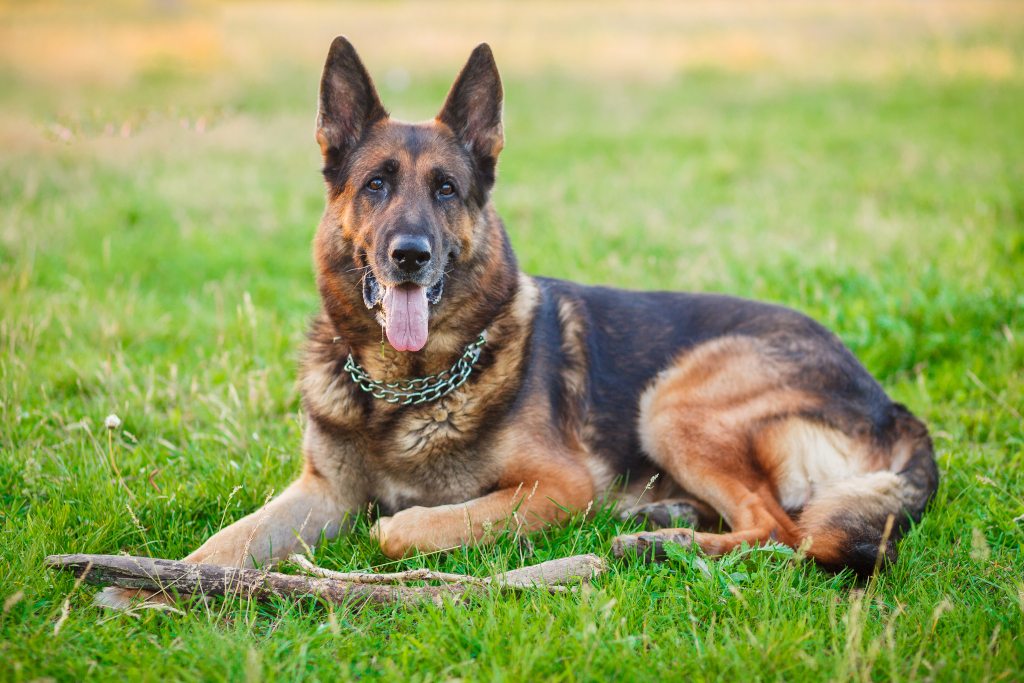
Known for its imposing and athletic structure, the German Shepherd is well-balanced and carries itself with poise.
Male German Shepherd Dogs usually weigh between 65 and 90 pounds and have a height of 24 to 26 inches, whereas females weigh around 50 to 70 pounds and stand about 22 to 24 inches tall.
Their heads are proportionate to their bodies, with a slightly arched forehead and a wedge-shaped muzzle. Their body is slightly elongated when compared to their height.
They have a medium-length, dense, double coat, which is usually black and tan, although it can come in other colors such as black and cream, black and red, sable, black, and even white.
You May Also Like: 5 German Shepherd Varieties You Probably Didn’t Know Existed
| Aspect | Doberman | German Shepherd |
|---|---|---|
| Male Weight | 75 to 100 pounds | 65-90 pounds |
| Male Height | 26 to 28 inches | 24-26 inches |
| Female Weight | 60 to 90 pounds | 50-70 pounds |
| Female Height | 24 to 26 inches | 22-24 inches |
| Build | Compact and muscular | Athletic and balanced |
| Coat Type | Sleek and short | Dense, medium-length |
| Colors | Black, red, blue, fawn with rust markings | Black & cream, black & red, black & silver, black & tan, black, gray, sable, white, liver, blue, bi-color |
** Comparison Table: Doberman vs. German Shepherd - Physical Appearance
Temperament and Personality: German Shepherd vs. Doberman
Doberman
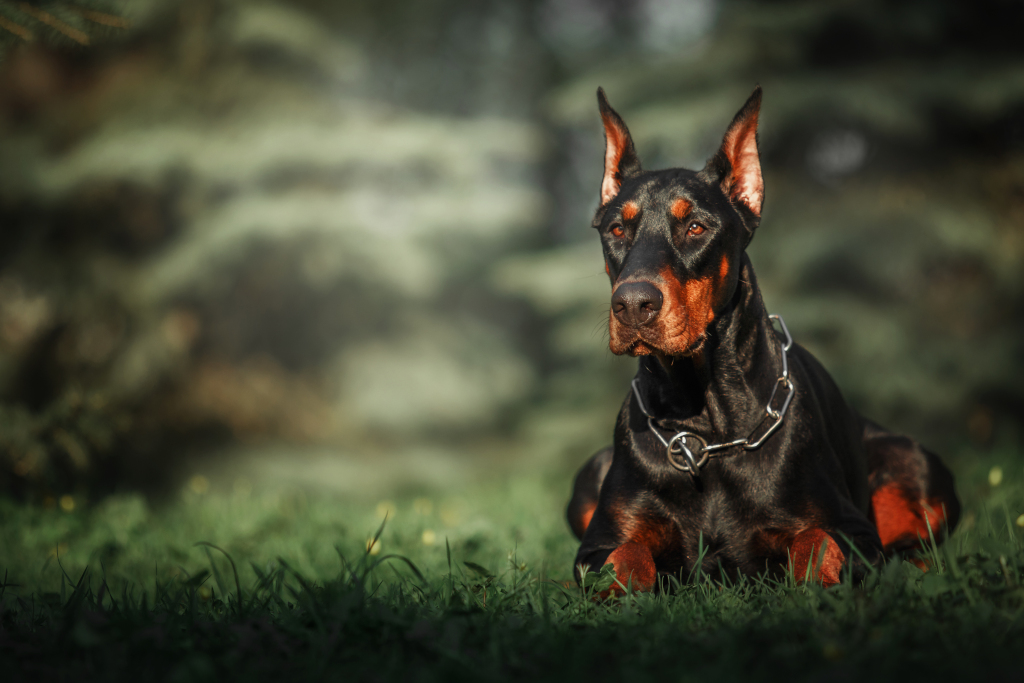
The Doberman is often perceived as an aggressive breed due to its historic role as a guard dog, but beneath that protective exterior lies a heart full of loyalty and affection.
These dogs are known to be fiercely loyal to their families and can be particularly affectionate with children. While their protective instincts are undeniable, they are not inherently aggressive without reason. Instead, they are intelligent, alert, and responsive, instinctively knowing when to be on guard and when it is ok to relax.
With proper socialization, they can be amicable with strangers and other dogs. Doberman Pinschers are also known for their high energy levels and, therefore, require regular exercise to keep them mentally and physically stimulated.
You May Also Like: Discover the Top 10 Guard Dogs That Are Burglar’s Worst Nightmare!
German Shepherd
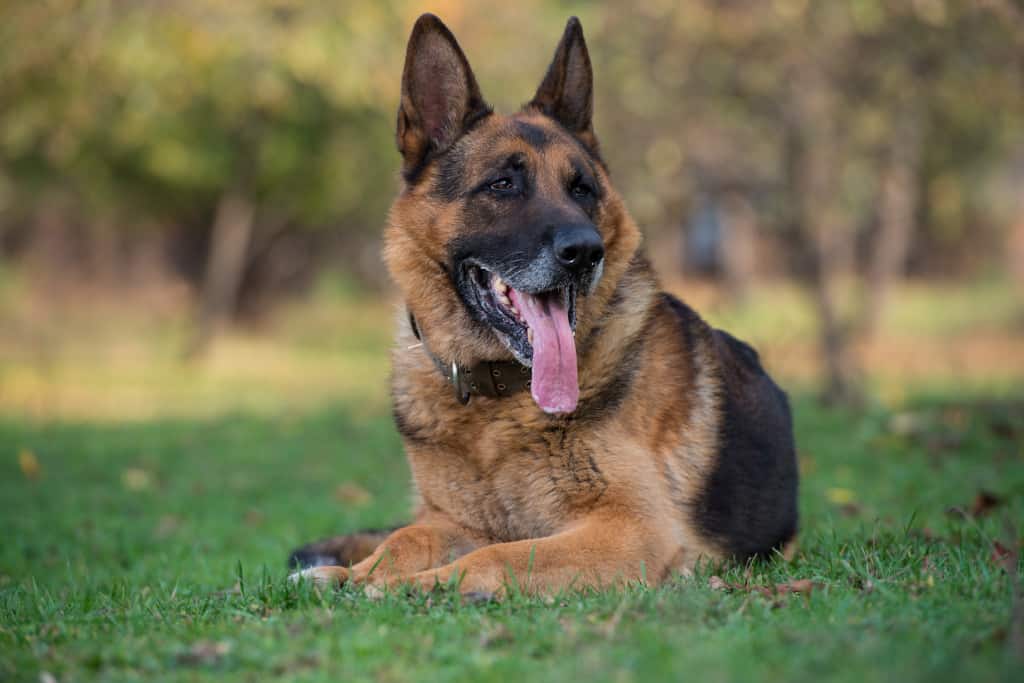
The German Shepherd is celebrated for its versatility in both work and companionship. Known to be incredibly loyal, they form strong bonds with their families and are protective of those they love, though not as intensely protective as Dobermans.
Like the Dobies, they possess a high intelligence quotient and, in fact, often rank among the top breeds for intelligence. This intelligence, combined with their strong work ethic, makes them quick learners and eager participants in various tasks.
While they can be wary of strangers, they’re generally more approachable than Dobermans.
Socialization from a young age is crucial to ensure they are well-rounded and adaptable in various situations. GSDs are also active dogs, requiring regular exercise and mental stimulation.
| Aspect | Doberman | German Shepherd |
|---|---|---|
| Loyalty | Extremely loyal to family | Extremely loyal to family |
| Intelligence | Highly intelligent, alert, and responsive | Among the top breeds for intelligence, quick learners |
| Protection Instinct | Intense protective instincts | Protective but not as intense as Dobermans |
| Interaction with Strangers | Guarded with strangers | Wary of strangers but are generally more approachable than Dobermans |
| Interaction with Children | Affectionate with children, very protective | Protective and gentle with children |
** Comparison Table: Doberman vs. German Shepherd - Temperament and Personality
Energy Level and Exercise Needs
Doberman
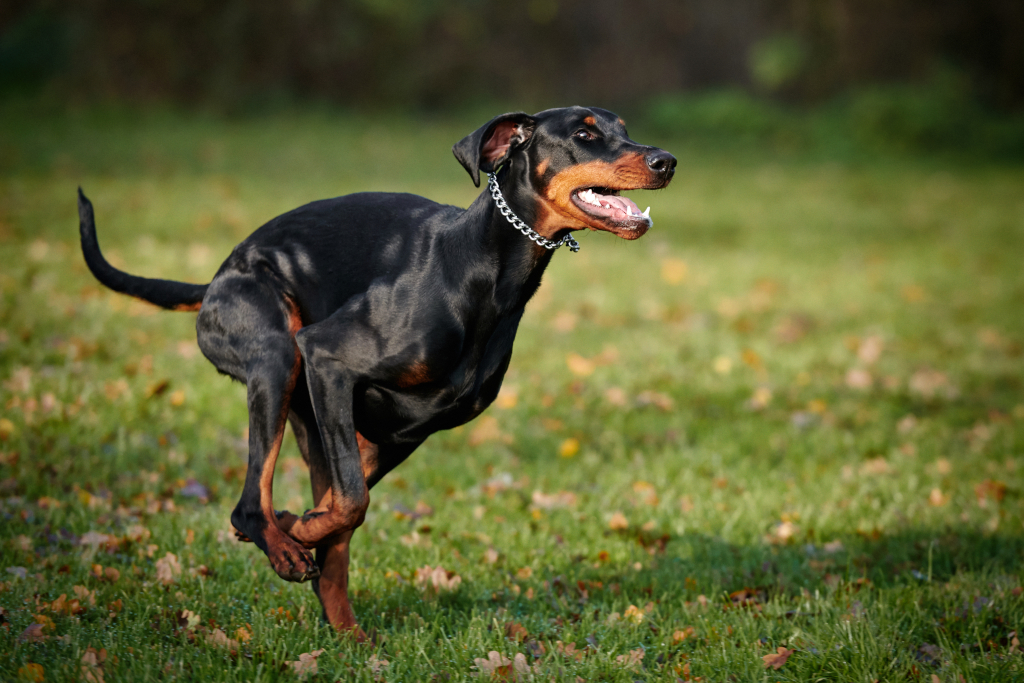
The Doberman is an embodiment of energy and athleticism. Originating from a blend of breeds selected for stamina and strength, it’s no surprise that they require regular, vigorous exercise.
Daily activities such as brisk walks, jogs, and play sessions are not just beneficial for their physical health but also essential for mental stimulation. Without adequate exercise, Dobermans can become restless, exhibiting behavioral issues.
Their high intelligence also means they thrive when presented with challenges, making activities like puzzle toys and advanced obedience training ideal.
You May Also Like: Guide to Cross-Country Running With Your Dog
German Shepherd
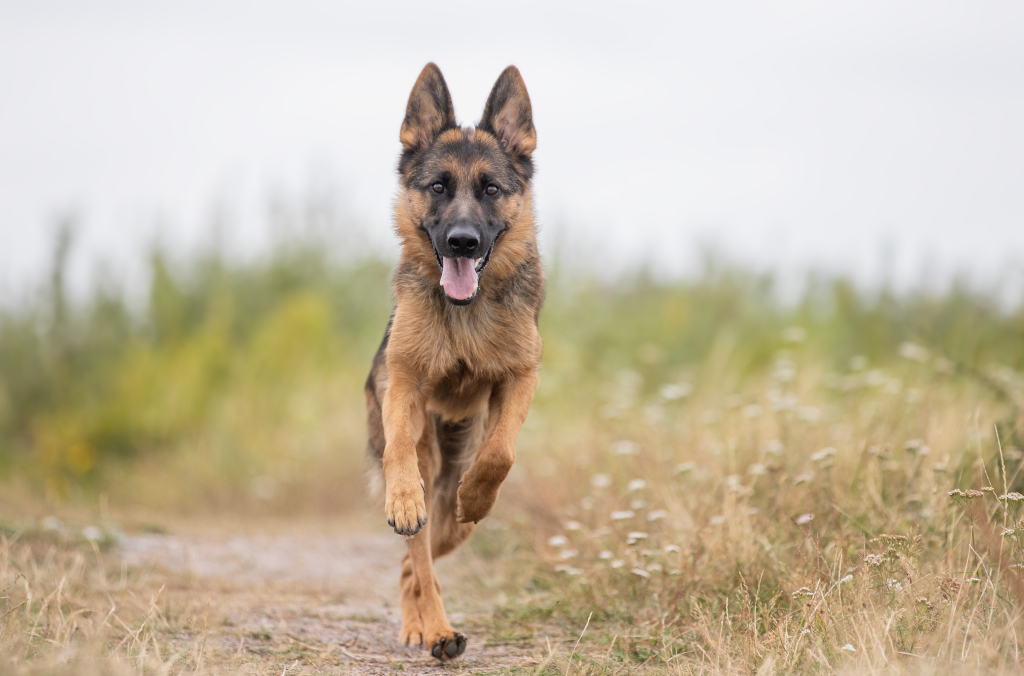
A breed renowned for its work in police and military roles, the German Shepherd has exercise needs that mirror its active lineage.
These dogs are brimming with energy and require daily workouts to stay fit and content. Activities such as hiking, jogging, and biking are right up their alley.
In addition to physical exercise, German Shepherds need mental challenges, given their sharp intellect. Training sessions, scent work, and problem-solving games are excellent ways to engage their minds.
You May Also Like: Training Your Dog to Run Alongside Your Bike: Step-by-Step Guide
| Aspect | Doberman | German Shepherd |
|---|---|---|
| Energy Level | High | High |
| Exercise Needs (Per Day) | 1 to 1.5 hours | 2 hours |
** Comparison Table: Doberman vs. German Shepherd - Energy Level and Exercise Needs
Note: Both the German Shepherd and the Doberman are high-energy breeds that thrive in active environments. A commitment to meeting their exercise and activity needs will not only ensure their physical well-being but also lead to a more harmonious coexistence. Given their intelligence, incorporating mental stimulation into their routine is just as crucial as physical activity.
Training and Socialization
Doberman
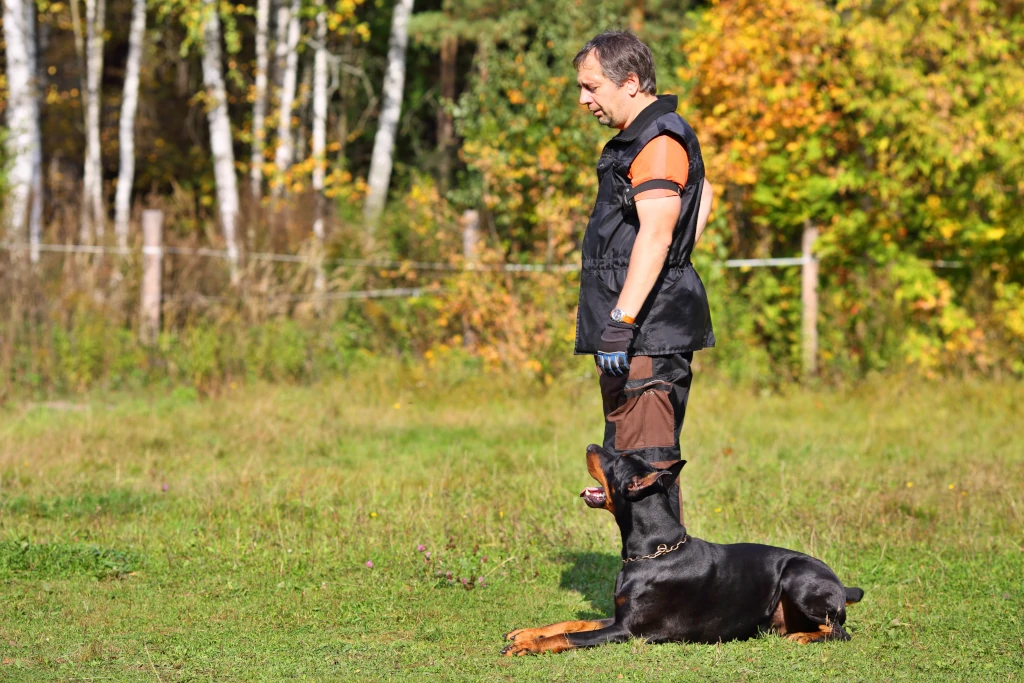
The Doberman’s sharp intellect and keen senses make it a receptive pupil, but it also possesses a confident demeanor that necessitates a balanced training regimen.
Consistent, positive, and reward-based methods resonate most with Dobermans, helping to mold their assertive character into a controlled and reliable companion.
Early and extensive socialization plays a pivotal role for the Doberman. Given their strong protective instincts, a wide array of experiences with different people, animals, and environments in their formative months is essential to cultivate a well-adjusted adult dog.
You May Also Like: Tips for Successful Clicker Training
German Shepherd
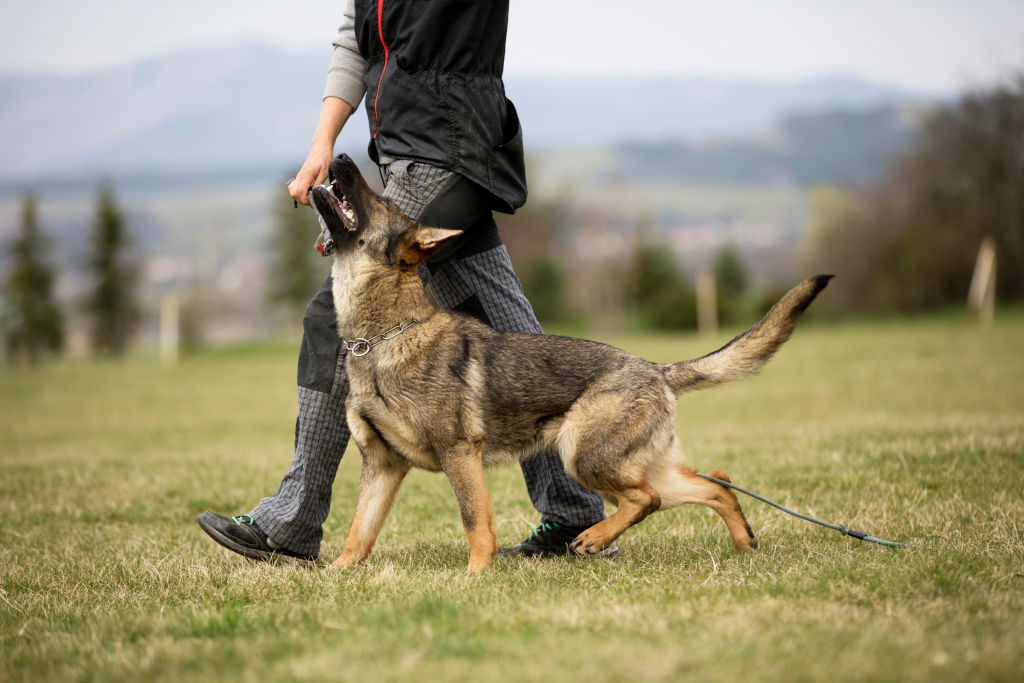
German Shepherds, with their storied history as working dogs, display a natural affinity for training. Their inherent curiosity makes them apt students, responsive to structured training sessions that challenge their intellect.
While German Shepherds tend to be more approachable than Dobermans, early socialization is equally important for them. Introducing them to diverse settings, individuals, and animals ensures a rounded German Shepherd that can adeptly navigate various situations.
You May Also Like: 7 Proven Dog Training Methods Every Owner Should Know
| Aspect | Doberman | German Shepherd |
|---|---|---|
| Ease of Training | Easy | Easy |
| Learning Speed | Highly receptive due to their sharp intellect | Naturally curious and driven, making them apt students |
** Comparison Table: Doberman vs. German Shepherd - Training and Socialization
Note: In the realm of training and socialization, both Dobermans and German Shepherds require dedication and a nuanced approach. Understanding the intrinsic qualities of each breed is paramount. With the right guidance, both breeds can emerge as not only obedient companions but also as well-integrated members of the community. Investing time in their early development ensures a fulfilling bond in the long run.
Health and Lifespan
Doberman
Typically, a Doberman’s lifespan ranges from 10 to 12 years. They are generally healthy dogs, but like many purebred canines, they come with their own set of health concerns.
Some common health issues that Dobermans face include cardiomyopathy (a heart condition), hip dysplasia, and von Willebrand’s disease (a bleeding disorder).
German Shepherd
Comparatively, German Shepherds have a slightly shorter lifespan of around 7 to 10 years.
However, being a popular breed, they have been subjected to a lot of breeding, leading to some hereditary health problems. These might include hip and elbow dysplasia, degenerative disc disease, bloat, and certain skin problems.
| Aspect | Doberman | German Shepherd |
|---|---|---|
| Lifespan | 10 to 12 years | 7 to 10 years |
| Common Health Concerns | Hip dysplasia, dilated cardiomyopathy, von Willebrand's disease | Hip and elbow dysplasia, degenerative disc disease, bloat |
** Comparison Table: Doberman vs. German Shepherd - Health and Lifespan
Note: Both Dobermans and German Shepherds, with their respective health concerns, benefit significantly from early preventive measures, regular health checks, and a balanced lifestyle. Owners need to be aware of the specific health challenges their chosen breed might face, ensuring they provide the best care to prolong their dog's life and improve its quality.
Nutrition and Diet
Doberman
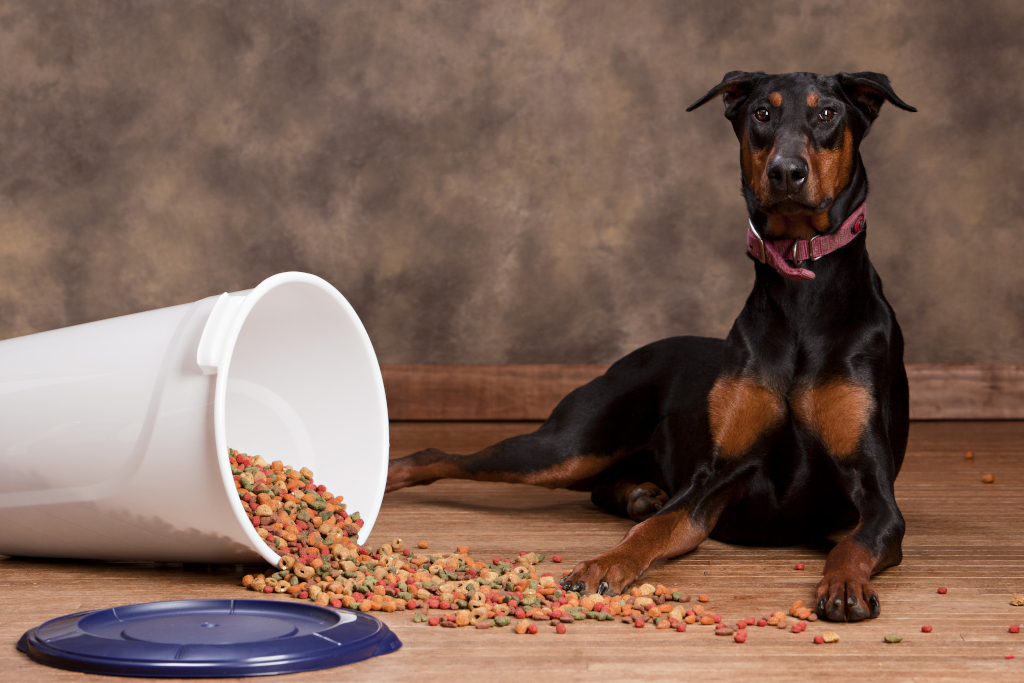
Dobermans are energetic and muscular dogs, which means they require a diet rich in high-quality protein sources to maintain muscle health. Fats are also essential for energy, but it’s crucial they come from good sources like fish oil, which provides essential omega fatty acids.
Since they can be prone to certain heart conditions, maintaining an optimal weight is crucial, making portion control and calorie monitoring essential.
A balanced intake of vitamins and minerals, especially calcium and phosphorus, supports bone health. Dobies can also benefit from joint supplements like glucosamine, especially as they age.
German Shepherd
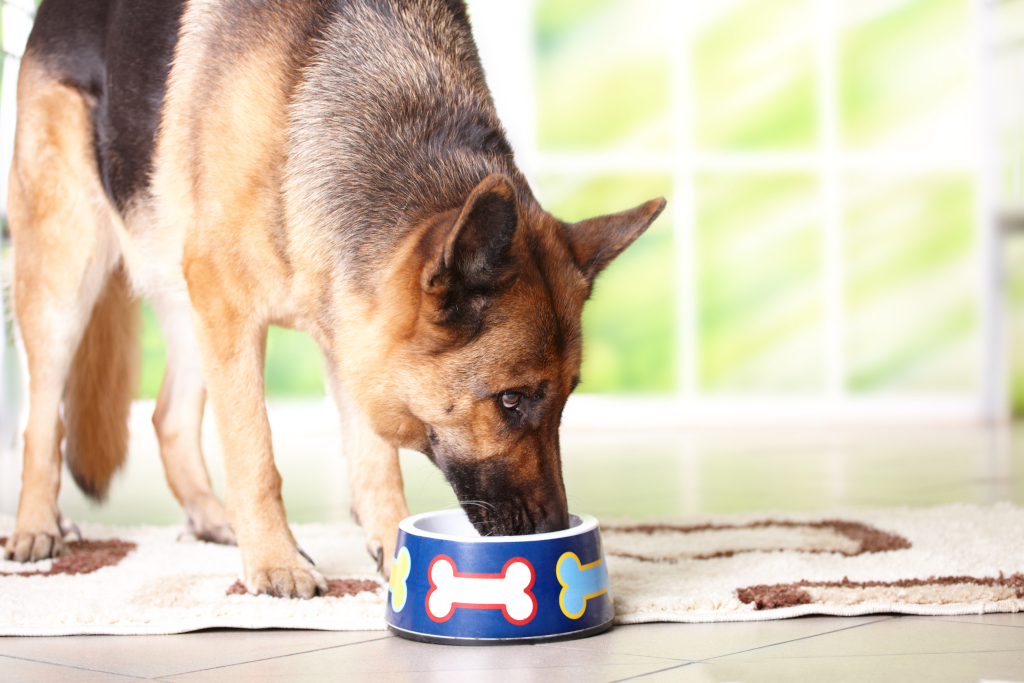
Being large and active, German Shepherds need a diet that supports their energy levels and bone structure. Kibbles formulated for large breeds, with high-quality protein sources as the main ingredient, such as chicken, beef, or lamb, are ideal.
They also benefit from healthy fats, with a special emphasis on omega fatty acids for coat health. Given their predisposition to hip dysplasia, maintaining an ideal weight is crucial to reduce stress on joints.
Adequate calcium and phosphorus intake is essential for bone development, especially in growing puppies. Digestive health is another concern, so incorporating fiber and probiotics can be beneficial for German Shepherds.
| Aspect | Doberman | German Shepherd |
|---|---|---|
| Average Daily Kibble Intake | 4 to 7 cups | 3 to 4 cups |
| Meal Frequency | Twice a day | Twice a day |
** Comparison Table: Doberman vs. German Shepherd - Nutrition and Diet
Note: A dog's diet directly affects its overall well-being. Whether you choose commercially produced dog food or opt for home-cooked meals, it's imperative to ensure the chosen diet meets the breed's specific needs. Consultations with a veterinarian can provide tailored advice, keeping your Doberman or German Shepherd in peak health.
Grooming Needs: Doberman Pinscher vs. German Shepherd
Doberman
Dobermans sport a sleek, short coat that is relatively low-maintenance. Regular brushing, at least once a week, can help remove loose hair and distribute natural oils across the skin, ensuring a shiny coat.
Bathing can be done as needed, usually every couple of months, or when the dog gets particularly dirty.
Additionally, their ears, regardless of whether cropped, require periodic cleaning to prevent infections. Regular nail trimming, teeth brushing, and occasional ear cleaning are also essential.
You May Also Like: Top-Rated Dog Nail Grinders
German Shepherd
German Shepherds come with a dense double coat requiring more rigorous grooming, which you should aim for at least two to three times a week.
They undergo seasonal shedding, particularly in spring and fall, so daily brushing during these times can help manage the hair fallout. Using an undercoat rake can be particularly useful in removing the loose undercoat.
Like Dobermans, German Shepherds also require occasional baths, nail trimming, teeth brushing, and ear cleaning.
You May Also Like: Top-Rated Dog Ear Cleaners
| Aspect | Doberman | German Shepherd |
|---|---|---|
| Shedding Amount | Moderate | Heavy and even more so during shedding seasons |
| Brushing Frequency | Once a week | Daily during shedding seasons, else 2-3 times a week |
| Bathing Frequency | Every couple of months or as needed | As needed |
** Comparison Table: Doberman vs. German Shepherd - Grooming Needs
Puppy Prices: Doberman Pinscher vs. German Shepherd
Doberman
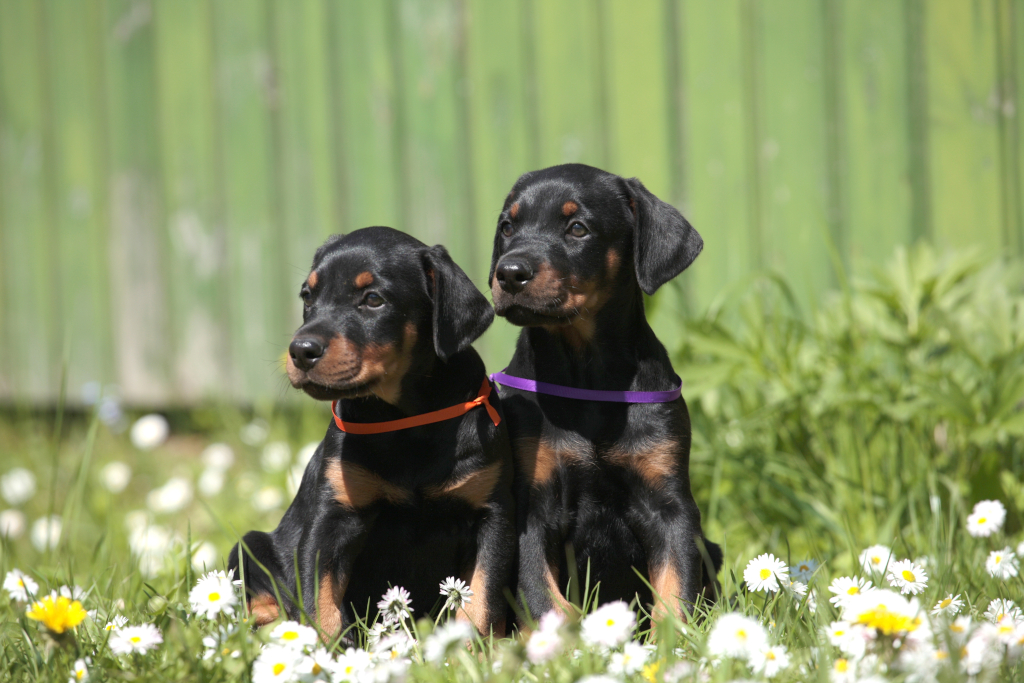
The price of a Doberman puppy can fluctuate based on factors such as pedigree, lineage, and breeder reputation. Puppies from show or champion lines tend to be more expensive.
Additionally, puppies sold with breeding rights or for show purposes might also come at a premium.
The typical price tag for a Doberman puppy from a reputable breeder sat between $1,500 and $2,500. However, if one seeks exclusive lines or breeding privileges, the price can jump beyond $2,500.
German Shepherd
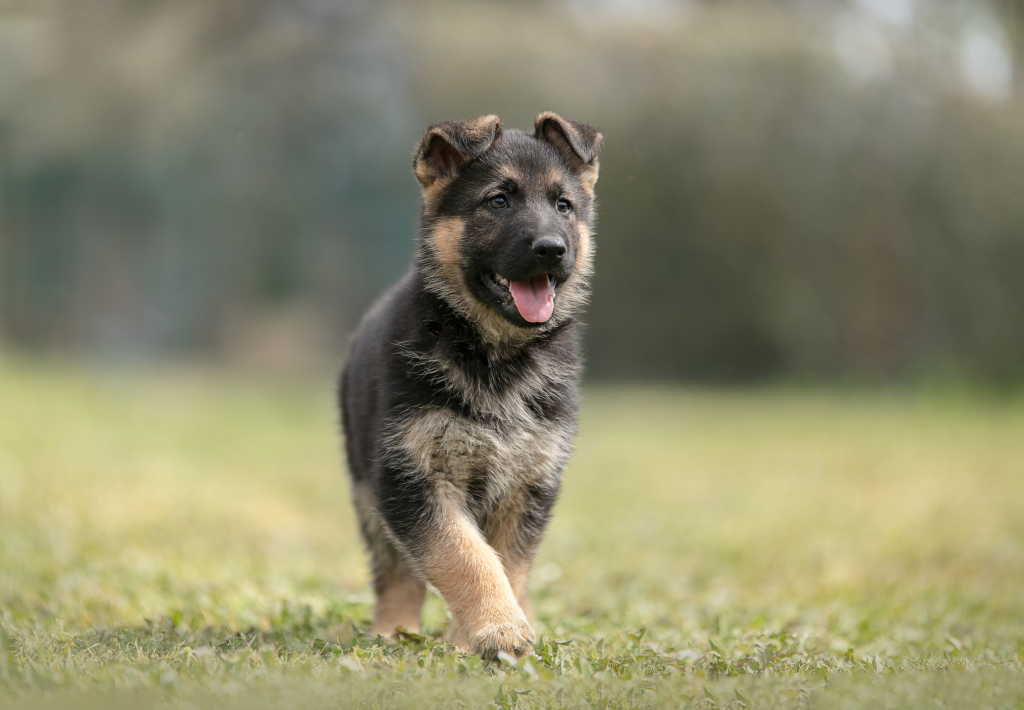
German Shepherds, being one of the most popular dog breeds worldwide, also exhibit price variations based on lineage, training, and breeder’s reputation. Working lines, especially those with a history in police or military service, can be pricier.
On average, a German Shepherd puppy from a well-regarded breeder might cost between $1,000 and $4,000.
Puppies from champion lines can exceed $4,000, and pups from specialized working lines or service lines can cost up to $20,000 due to the training they’ve received even though they didn’t pass the requirements and necessary tests to serve in the official capacity.
You May Also Like: True Costs of Owning a German Shepherd
| Aspect | Doberman | German Shepherd |
|---|---|---|
| Average Price Range | $1,500 to $2,500 | $800 to $4,000 |
| Elite Lineage Cost | Typically above $2,500 | Often above $4,000 |
| Commonality | Reasonably common | Highly popular |
** Comparison Table: Doberman vs. German Shepherd - Puppy Prices
Note: It's crucial to note that the initial cost of the puppy is just the beginning. Owning a dog comes with continuous expenses, including food, health care, training, grooming, and more. Also, while price can be an indicator of quality, it isn't always the best measure. Potential owners should research the breeder they are interested in and look into the puppy's background, health tests, and other important factors to ensure the puppy is a healthy, happy addition to your family.
Which Breed is Better For You? Doberman Pinscher or German Shepherd?
Choosing the right canine companion is a journey that involves weighing various factors, and when the choice boils down to the Doberman Pinscher and the German Shepherd Dog, the decision becomes even more nuanced.
Both breeds, known for their intelligence, loyalty, and protective nature, have unique attributes that might align better with specific lifestyles and preferences. Below are some of the key points to consider when choosing between the two breeds.
| Consideration | Doberman | German Shepherd |
|---|---|---|
| Lifestyle Compatibility | Active | Active |
| Guardian Instincts | Intensely protective | Protective but more approachable |
| Trainability | High | High |
| Grooming Needs | Low-maintenance short coat | Regular brushing due to double coat |
| Tendency to Bark | Moderate, mostly alert barks | Moderate to high |
| Cold Weather Tolerance | Low | High |
| Hot Weather Tolerance | Moderate to high | Moderate |
In conclusion, the decision between a Doberman and a German Shepherd isn’t about which breed is superior. It’s about which breed aligns more closely with your life, environment, and what you desire in a dog.
Both breeds can offer a lifetime of companionship, loyalty, and joy when given the right care, love, and training.
Frequently Asked Questions About German Shepherd vs. Doberman
Q1: Which breed is more popular as a family pet: Doberman or German Shepherd?
A: The German Shepherd is generally more popular as a family pet, in part because of its versatile roles in police, military, and service work, which has boosted its public profile. However, Dobermans are also loyal and affectionate family dogs.
Q2: Who is the better guard dog? Doberman or German Shepherd?
A: The Doberman is often considered the superior guard dog. Their intimidating size, appearance, heightened sense of alertness, and deep loyalty to their handler make them especially effective for protection. Their specific breeding for guarding tasks gives them an edge in specialized protective roles, and their swift response time allows them to act quickly against threats.
Q3: Are German Shepherds more aggressive than Dobermans?
A: Aggression largely depends on the individual dog, its training, and upbringing. Neither breed is inherently aggressive. Both Dobermans and German Shepherds are known to be protective, but with proper socialization and training, they can be well-behaved and balanced.
Q4: Why do police use German Shepherds instead of Dobermans?
A: German Shepherds are versatile working dogs that can be trained for various tasks, including protection, detection, and search and rescue. Their trainability, intelligence, and resilience make them a preferred choice for many police forces. While Dobermans have also been used in police and military roles in the past, the versatility of the German Shepherd often makes them a more popular choice.
Q5: Can a German Shepherd defeat a Doberman?
A: It’s crucial not to encourage or glorify dog fights. Both breeds are strong and can cause harm if provoked. Outcomes of confrontations can vary based on the individual dogs, their temperaments, health, size, and other factors. Responsible dog ownership means preventing such situations from arising.
Q6: Is a German Shepherd bite stronger than a Doberman?
A: Bite force can vary among individual dogs, but on average, the Doberman’s bite is stronger than that of a German Shepherd, with the Doberman having a bite force of around 305 psi of pressure as compared to the German Shepherd’s average of about 238 psi.

